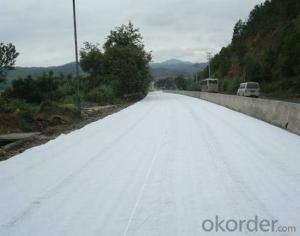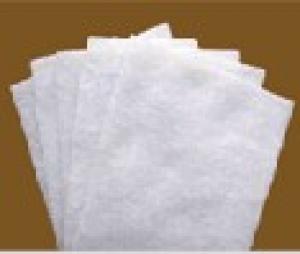IWT Geotextiles Pet Woven Geotextile for Roadbeds Construction
- Loading Port:
- Qingdao
- Payment Terms:
- TT or LC
- Min Order Qty:
- 20000 m²
- Supply Capability:
- 1500000 m²/month
OKorder Service Pledge
OKorder Financial Service
You Might Also Like
Specifications of PET Woven Geotextile Used for Roadbeds Construction:
Filament Spunbond
High Tensile, Strength,Easy
Polyester Geotextile Fabric
In-house, OEM accept
Long Fiber, Staple Geotextile
Characteristic of PET Woven Geotextile Used for Roadbeds Construction:
1. High strength: using high strength industrial polypropylene, Dacron, Chinlon etc. as the fiber raw materials that has higher original strength. And then, weaving formed a textile through a certain way and its comprehensive bearing capacity reaches a higher level.
2. Durability: Synthetic fiber is stable in physical property and is not easy going to decomposing & weathering.
3. Corrosion resistance: Synthetic fiber always has good characteristic like acid-resisting, alkali-resisting, damage from insects & mold.
4. Water Permeability: Woven geotextile can control effectively its opening in structure and reach a certain permeability.
5. Easy for Store & Transport: It is easy to store and transport owing to its light weight and certain package.
Application of PET Woven Geotextile Used for Roadbeds Construction:
1. It is a series industrial products of geo-material that suit for all kinds of characteristics & requirements in Geotechnical engineering and is widely used in rivers, coast, road, railway, dock, tunnel, bridge and so on. Most important, it can reach all different applications.
2. In order to guarantee stable & balanced structure and reach all engineering data, all our woven geotextile produced by import width shuttleless loom to guarantee quality.
3. The series of products is filter, brace, anti-skidding, mould bags etc.


- Q: Can geotextiles be used in erosion control mats?
- Yes, geotextiles can be used in erosion control mats. Geotextiles are often used as a component in erosion control mats to provide reinforcement and stabilization, helping to prevent soil erosion and promote vegetation growth.
- Q: Can geotextiles be used in landfill construction?
- Yes, geotextiles can be used in landfill construction. They are commonly used as liners, covers, and drainage materials in landfills to prevent soil erosion, control water flow, and improve stability and performance of the landfill structure.
- Q: How do geotextiles contribute to pavement design?
- Geotextiles play a crucial role in pavement design by providing various benefits. They help in enhancing the structural integrity of the pavement by distributing loads more uniformly, minimizing stress and preventing cracking. Geotextiles also act as a separator, preventing the mixing of subgrade soil with the overlying pavement layers. Additionally, they aid in filtration by allowing water to pass through and drain efficiently, preventing water buildup and potential damage. Overall, geotextiles contribute to the longevity and durability of pavements by improving their performance and reducing maintenance needs.
- Q: What is the effect of tunnel geotextile failure on tunnel quality
- Poor quality geotextile certainly have an impact ah, I am professional production of geotechnical materials wish smooth
- Q: What are the advantages of using geotextiles in hydraulic applications?
- Geotextiles offer numerous advantages in hydraulic applications. Firstly, they provide effective filtration, allowing water to pass through while retaining fine particles and preventing clogging of drainage systems. Additionally, geotextiles enhance soil stability and prevent erosion by reinforcing the soil structure. They also aid in water drainage and control, reducing the risk of excess water buildup and potential damage to infrastructure. Geotextiles are easy to install and cost-effective, making them a practical choice for various hydraulic projects.
- Q: How is the strength of geotextiles determined?
- The strength of geotextiles is determined through various mechanical tests such as tensile strength, puncture resistance, and burst strength. These tests measure the ability of the geotextile to withstand forces and stresses, providing an understanding of its overall durability and performance in different applications.
- Q: What are the advantages of using geotextiles over traditional construction materials?
- Geotextiles offer several advantages over traditional construction materials. Firstly, they provide enhanced stability and reinforcement to the soil or other substrates, reducing the need for extensive excavation or additional structural support. Secondly, geotextiles are permeable, allowing water to pass through while preventing soil erosion, thus improving drainage and reducing the risk of flooding. Additionally, geotextiles are lightweight and easy to handle, making them cost-effective and efficient to install. Lastly, these materials have high resistance to environmental factors such as chemicals, UV radiation, and biological degradation, enhancing their longevity and durability. Overall, geotextiles provide a versatile and sustainable solution for a wide range of construction applications.
- Q: Can geotextiles be used for reinforcement of underground tunnels?
- Yes, geotextiles can be used for reinforcement of underground tunnels. Geotextiles are commonly used in civil engineering projects, including tunnel construction, to provide reinforcement, drainage, and separation. In the case of underground tunnels, geotextiles can be installed to prevent soil erosion, provide stability, and enhance the overall structural integrity of the tunnel.
- Q: How do geotextiles help in reducing the impact of heavy rainfall on soil?
- Geotextiles help in reducing the impact of heavy rainfall on soil by acting as a barrier between the soil and the water. They provide reinforcement to the soil, preventing erosion and soil displacement caused by the force of the rainfall. Additionally, geotextiles allow water to infiltrate into the soil and drain efficiently, reducing the risk of waterlogging and improving the overall stability of the soil during heavy rainfall events.
- Q: Do you want to put the geotextile and the impounded vegetables in the soil?
- No poison, you can rest assured that use. Geotextile raw materials are PET or PP, and the production of mineral water bottles of raw materials the same, without any side effects. Water storage board is the raw material is HDPE plastic. There is no harm to people. Geotextile and water storage board is mainly used in the roof garden or underground garage roof green. It is possible to store rainwater and protect the concrete at constant temperature. , Has been widely used in developed countries. At present the country is developing urban sponge project, the application of water storage board will be more extensive.
Send your message to us
IWT Geotextiles Pet Woven Geotextile for Roadbeds Construction
- Loading Port:
- Qingdao
- Payment Terms:
- TT or LC
- Min Order Qty:
- 20000 m²
- Supply Capability:
- 1500000 m²/month
OKorder Service Pledge
OKorder Financial Service
Similar products
Hot products
Hot Searches
Related keywords




























